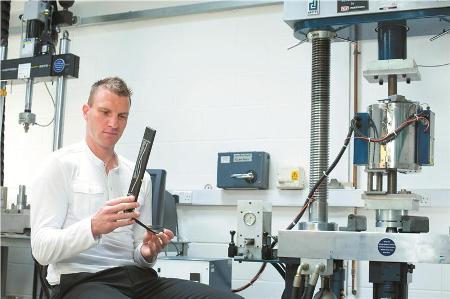Jan 9 2013
Approximately one in every 1,000 people in the UK is an amputee. Many lose their limbs as the result of tragic accidents or due to active military combat and for some amputees losing a limb can feel like losing their freedom.
 Prosthetics_BryceDyer
Prosthetics_BryceDyer
Engineers at Bournemouth University (BU) are turning an academic concept into a practical product that could lessen the misery of thousands of amputees.
They are creating a ‘smart socket’ – a lower-limb prosthetic which can adjust itself to fit the changing shape of the limb stump it connects with. The design team say the fit will be so comfortable that amputee servicemen may even be able to return to active combat.
“Many prosthetic limbs remain unused simply because they can be so uncomfortable over time,” says Bryce Dyer at BU’s Design Simulation Research Centre, where a team of mechanical engineers and clinicians led by Professor Siamak Noroozi, are developing the technology.
Fitting a false limb is currently “a bit of a black art” says Dyer. Prosthetists traditionally require decades of experience to do their job successfully and are dependent upon the subjective feedback of patients, with no other method of measuring fit.
Additionally, current technology does not allow for changes in volume– patients’ stumps may swell and contract. “It’s like having your feet change size on a daily basis and expecting your shoes still to fit comfortably,” says Dyer.
Calling on combined expertise, BU’s School of Design, Engineering and Computing is using artificial intelligence to create a self-learning system that will measure interactions between socket and limb stump during the fitting and wear. “It is very much at a research and development stage,” says Dyer.
Currently the team are also attempting to miniaturise the technology to make it light and portable as well as incorporating wireless technology.
BU scientists have teamed with commercial partners at prosthetics and orthotics supplier Chas A Blatchford & Sons, who work with the Ministry of Defence Medical Rehabilitation Centre in Surrey, where injured soldiers are sent following service in Afghanistan and Iraq.
“One of the great things about this industrial partnership is that we will be able to get feedback from the very kind of people we are trying to help,” says Dyer.
With better fitting false limbs, medical costs will fall, say BU designers; with prosthetists able to get it right first time and requiring less experience to be able to do their job properly. Being agile enough to return to active service is a huge bonus for the rising numbers of amputee soldiers. “It will get them back in the field rather than being retired early or restricted in what they can do,” says Mr Dyer.
Understanding how elite sprinters perform with artificial limbs or “blades” and how different types of prostheses compare is central to another strand of Mr Dyer’s research.
“Paralympic running world records are still being set on a near annual basis – the sport hasn’t settled down yet. I’m looking at how individuals should be grouped together or separated – how to give the fairest possible race.”
As well as informing future Paralympic Committees, the research will apply to disability in sport in general. Should someone who’s lost both limbs compete against a runner missing just one limb, for example? And how should technology be categorised, when variations in quality of false limbs may create substantial differences among international athletes?
“Some 30 years ago, it was all about enabling disabled people to take part in sport,” says Dyer. “But now the quality of performances and the sums of money involved are so great, there’s much more at stake. We don’t want to restrict technology but we need to find a way to measure it.”